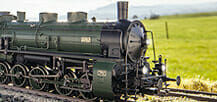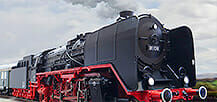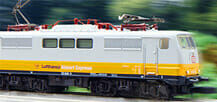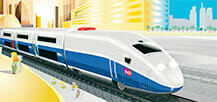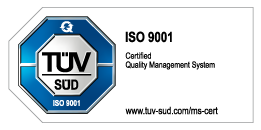Express Train Set.
Prototype: German Federal Railroad (DB) class 110 electric express locomotive with "pants crease" and 4 express train passenger cars in "Pop colors". 1 type Büm car, 2nd class (blue) and 1 type Aüm car, 1st class (orange). 1 type WRüge dining car (red) and 1 type Düm baggage car (green). In 1972 train D 611 was in regular service from Dortmund to the Olympic grounds in Munich.
Most Important Facts
| Article No. | 26512 |
|---|---|
| Gauge / Design type | H0 / 1:87 |
| Era | IV |
| Kind | Train Sets |
Check with your local dealer Find Dealer
-
Product description
Model: The locomotive comes with a digital decoder and controlled high-efficiency propulsion. 2 axles powered. 4 traction tires. The headlights will work in conventional operation and can be controlled digitally. The acceleration and braking delay can be controlled digitally with the 6021 Control Unit. The cars can be retrofitted with the 7319 plug-in current-conducting drawbars or the 72020 working current-conducting close couplers that can be uncoupled. The baggage car has roll-down doors. The cars have destination signs. Total length over the buffers 126.5 cm / 49-7/16".
Find more Märklin explanation videos on our YouTube Channel
Spare parts for our articles can be found here in our spare parts search.
One-time series.
-
Publications
- New items brochure 2004 - Product programme 2005 - Product programme 2006
-
Prototype information
German society changed in the 1960"s. The youth revolt broke the hardened political lines. Artists rebelled against traditional ways of seeing things, with Pop Art. The exhilarating and easily digested fare penetrated all areas of life. Light and exhilarating was also the feel of the glass tent architecture for Munich"s Olympia Park. The graphic artist, Otl Aicher, created a visual concept for the 72 Olympic games that included the pastel color tones of the rainbow. The German Federal Railways also followed the trend. The sad, dark green of the passenger cars dampened the spirit. Using the model of the special paint scheme of the Rheingold the company sought more modern, fresher, more dynamic colors for the express trains, which would enhance the image of the DB. In 1970 the DB commissioned 16 express train cars in cobalt blue/pebble gray. The colors chrome oxide green/pebble gray were intended for a second series of 24 cars. The new colors met with little enthusiasm from passengers, and little enthusiasm internally at DB. Only the pebble gray side walls were convincing; brighter friendlier colors were desired for the window strips. In the second approach there were cars with blood orange, cobalt blue, blue-violet, magenta, red-violet, and green window strips. The side walls were pebble gray, longitudinal girders and chassis were deep black, roofs were umbra-gray 1st class cars were marked with a yellow-gold identifying stripe. Thereafter, a portion of the 1st and 1st/2nd class coach cars delivered in 1970/71 were painted orange, 2nd class coach cars and 2nd class with baggage compartment were painted blue, dining car and sleeping car, as well as half dining car, were painted red, and the baggage car was painted green. The unusual rich coloring resulted in the nickname, pop cars. A total of 146 cars were given the pop treatment. The DB mostly sent the colorful trains from Bremen, Osnabrück, Norddeich and Dortmund to Munich. In addition, pop trains traveled the Basel - Hamburg route, later as DC trains as well. Due to the pop colors, the closed effect of the window strip made the cars look elongated and modern. Other railways copied the effect. The pebble-gray side walls however proved to be very sensitive to dirt. Consequently, in 1974 the DB selected ocean blue/beige as new standard colors. In 1985 the last pop cars were stationed in Munich. A little while later the DB returned to essential design elements of the pop cars for its new color concept for passenger cars.
